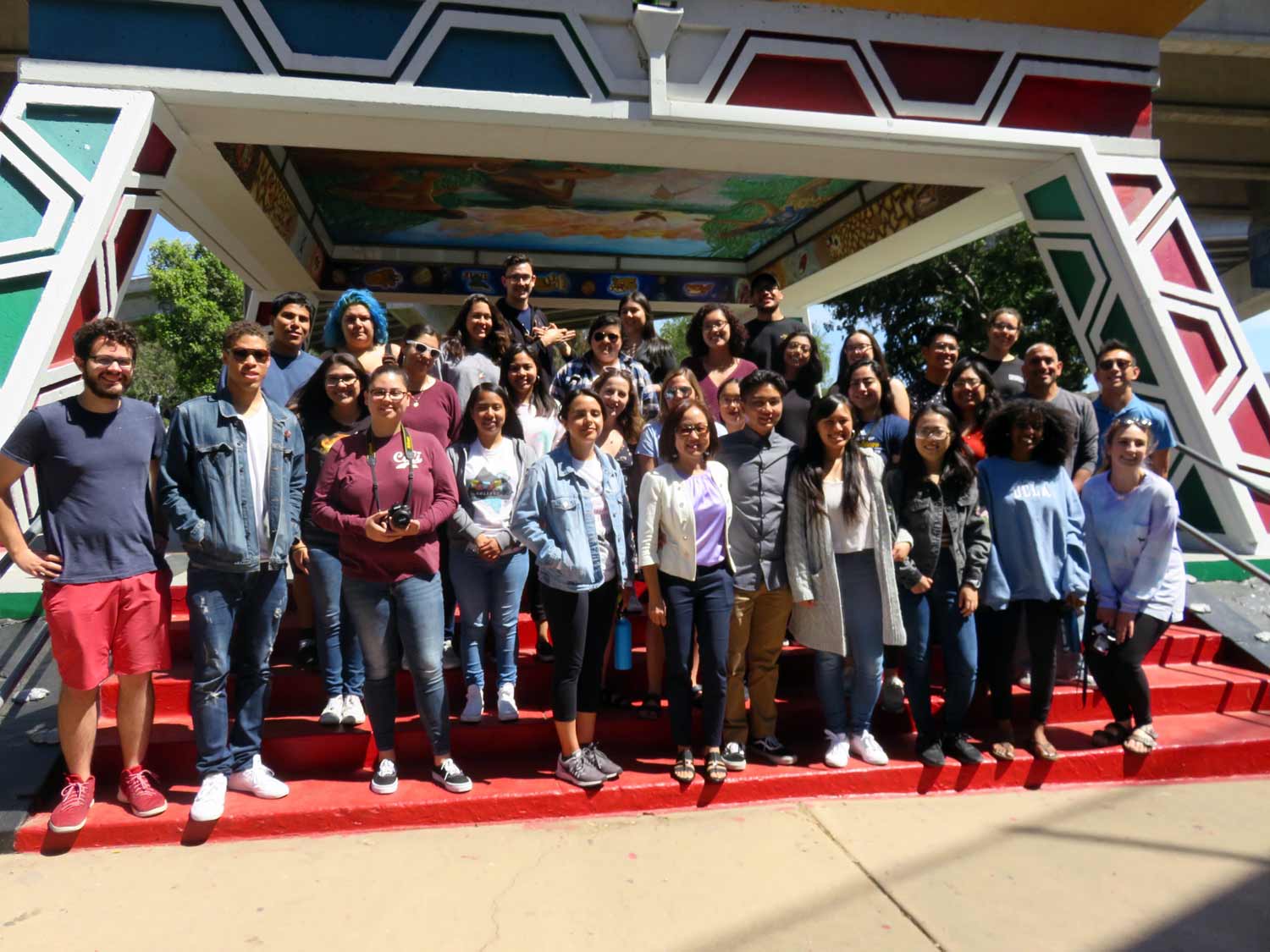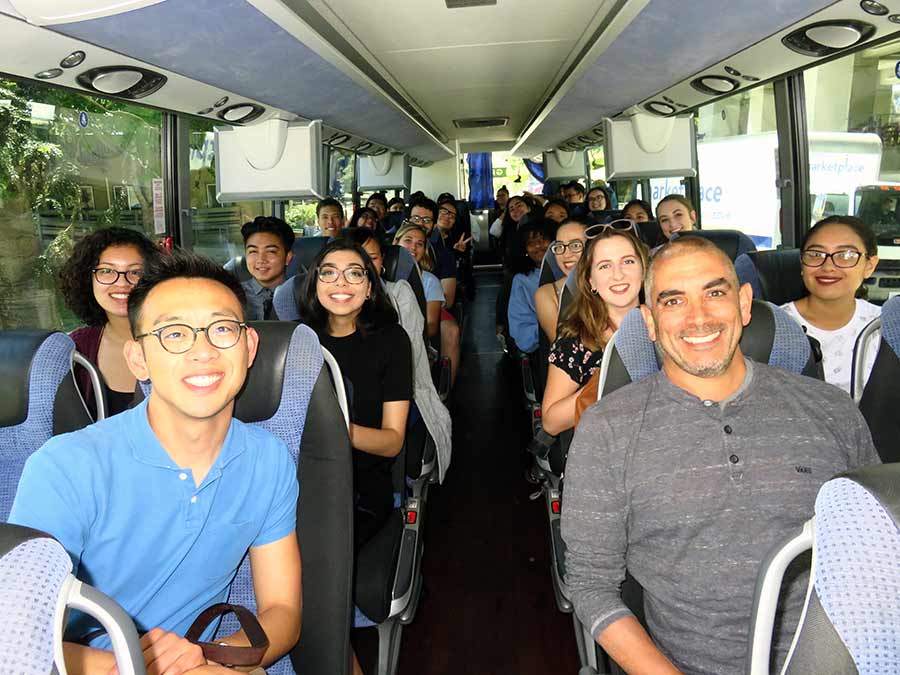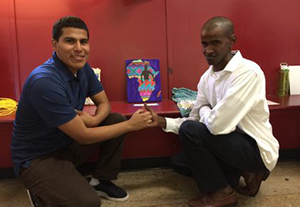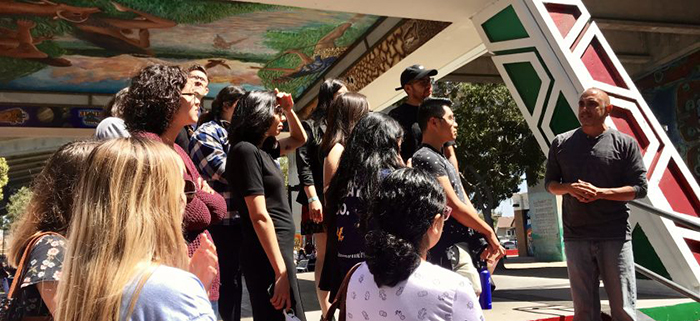By:
- Anthony King
Published Date
By:
- Anthony King
Share This:

UC San Diego students from the Race and Oral History Project, along with professors Yen Le Espiritu, Luis Alvarez and Simeon Man, visit Barrio Logan in spring 2018. (Photos courtesy UC San Diego Race and Oral History Project)
Building an Archive of San Diego History
UC San Diego students bring campus to community and back in new Race and Oral History Project
UC San Diego Department of History professor Luis Alvarez is very clear: the campus’s Race and Oral History Project is young, but growing — with lots of people involved both on and off campus.
The new project is intended to collect the stories and experiences of people who work and live in the greater San Diego region day to day, but who have largely been left out of how this history is told. As director of the Institute of Arts and Humanities, Alvarez said UC San Diego has the opportunity to correct this slight, telling a regional story in a way that is inclusive, and engaged with the people, cultures and organizations that make up this wide, diverse history.

Front row from left, professors Simeon Man and Luis Alvarez travel with UC San Diego students.
And UC San Diego students are loving it.
“The students,” Alvarez said, “found that this course was a way to not only learn that history, but to actually engage it and see it happening in a way that you don’t when you’re just meeting on campus, or you’re just reading about it. They were actually talking to people, meeting people and documenting that history themselves.”
The first Race and Oral History course was held in spring 2018, with about 40 students. And while it is an undergraduate course, Alvarez said that’s only one part of the collective that put this grassroots effort together.
A team of faculty members developed the class, including Alvarez, Simeon Man from the Department of History and Yen Le Espiritu from the Department of Ethnic Studies. Graduate students helped in the classroom itself, leading trainings and providing guidance. And campus partners were there too, including key help from the UC San Diego Library to train the students in archive theory and digital humanities.
The purpose is to not just train students to conduct oral histories, but to teach them something about the history of race in San Diego, and then develop an archive that can be housed at the Library for future access. They’ll help to build this archive over time, making UC San Diego a leader in collecting the region’s history, with a distinct focus on equity, diversity and inclusion.
“San Diego, in particular, has less published work about the city than many other places around the country do, so I think the motivation was to … give the students an opportunity to play a role in fixing this wrong and really starting a project that will hopefully have a very long life,” he said. “What this will be is an ongoing project that will be collaboratively and collectively owned by UCSD and San Diego.”
Click on the following track to listen.
The course itself is set up to be a very different kind of experience. Students spend time in the classroom, with readings each week that highlight different communities, and a longer study of race and ethnicity in the region that is typical of a history class.
They then learn how to take an oral history, with hands-on training that covers everything from how to make connections, how to design questions and how to use the technology, like monitoring recordings, checking for volume, transcribing interviews and posting them to their program website.
“I think that when they look back on UCSD, the four or five years they put in campus years from now, that this will be something that sticks out,” Alvarez said. “Not just because it was hard, but because it was different and it was unique and it put them in a place where they had to think about and talk to people, and do things that they otherwise might not have done.”
Last year, there were three community partners: Casa Familiar, a grassroots advocacy organization near the U.S.-Mexico border; United Women of East Africa, a cultural center in City Heights run largely by East-African women and refugees; and Che’Lu, and organization committed to the preservation and promotion of Chamorro culture, language and health.

From left, UC San Diego student Leonel Perez Hernandez interviewed Abdul Kadir Adawe.
Alvarez said that in developing the course, they didn’t want the community partners to think the university nor the students were exploiting them, and they didn’t want their agenda as researchers to in any way determine or shape the trajectory of the community partner’s agenda.
“What I think we really wanted to be a part of was holding conversations with them about how we can serve them,” he said. “And I think they’ll benefit from having UC San Diego students come through their sites and work with them. What that does is helps them see UC San Diego as a resource.”
Held again this Spring Quarter, students can register for the four-unit, upper division History course, and most will simultaneously take a two-credit Academic Internship that is used as the vehicle to get off campus and into community groups. In addition to United Women of East Africa, Alvarez said for 2019 they will be working with Barrio Logan College Institute, the Filipino American National Historical Society and Detainee Allies, a community group that advocates for and corresponds with refugees in an Otay Mesa detention center.
Collecting oral histories, writing and recording archives, engaging with community partners—what’s really happening is that UC San Diego students are building relationships, and showing how the university and community can work together.

Far right, Luis Alvarez speaks to students: “It's about creating moments where everyone involved can feel good about being a part of something that's bigger than themselves.”
Alvarez said it’s important to let the project grow organically, where everyone who can be involved, is, and it’s not about collecting oral histories without the input, cooperation and teamwork with the entire community: “It's about creating moments where everyone involved, all of the constituencies involved in the Race and Oral History Project, can feel good about being a part of something that's bigger than themselves.”
Share This:
Stay in the Know
Keep up with all the latest from UC San Diego. Subscribe to the newsletter today.



